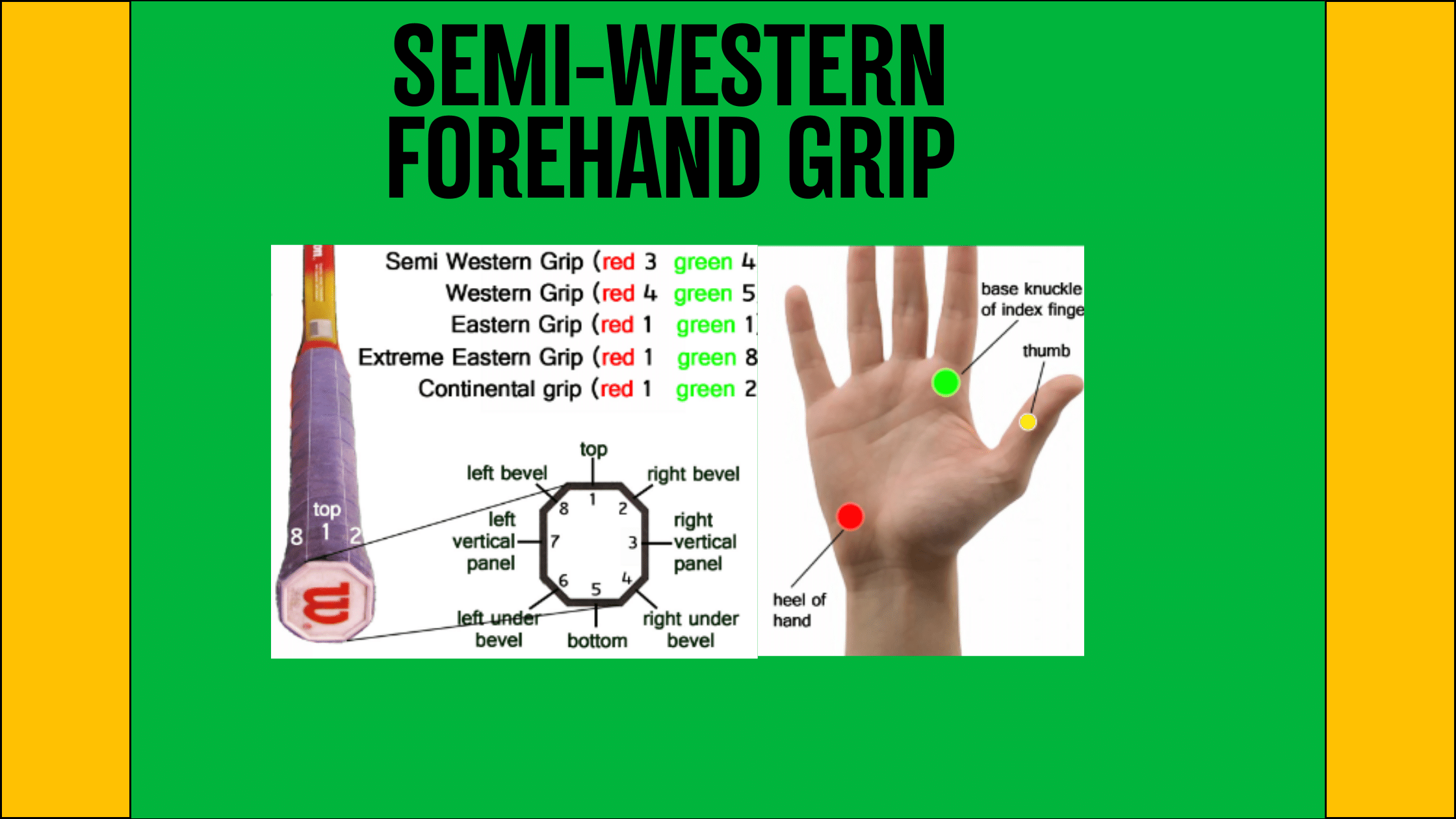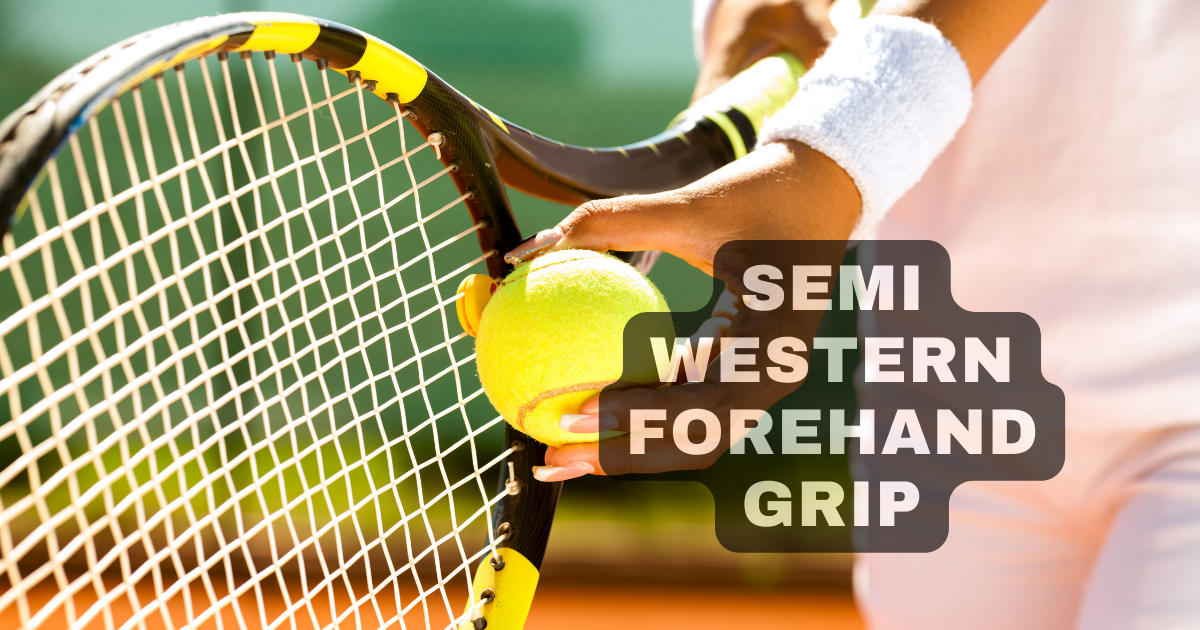Choosing the right grip is essential for every tennis player who wants to improve the game. Today we are discussing the Semi Western Forehand Grip. In modern tennis, the semi western forehand grip plays a vital role while playing the shots in the right direction with great power. Be a Pro, like a great player!
The Semi-Western grip, often known as the frying pan or the pancake grip, has quickly risen to prominence as 3rd ranked grip among players. This enables you to make powerful consistent, topspin, and net-clearing shots. Changing from one grip to another takes a long time, and we will not advise this if you have good competition. That’s why choosing the proper grip is a crucial first step in improving your tennis game. I tried several grips until I found the one that best suited my playing style.
My personal preference is for the hold that this grip gives us. This also aids in the creation of topspin and the advancement of shot speed. A semi-western grip is a solid option but has the same pros and cons as any other. To assist others, we have compiled all the necessary things that might help you with a “semi-western forehand grip.”
Best Ball Machine For Practicing at Home
A general overview of semi-western grip:
The semi-western grip is one of the most often utilized grips in professional Tennis today. It’s a forehand grip in Tennis that falls between traditional Eastern and extreme Full-western grip.
Some of the finest players in the world, including Rafael Nadal, Novak Djokovic, and Ashleigh Barty, now use a Semi-western grip. We, as players of Tennis, kept experimenting with grips as the racket became better and racket heads got bigger. Along with that, the Tennis’s development and rising level of competition, the semi-western grip emerged. It helps players smash very aggressive strokes while maintaining a large margin of error.
Although the name of this grip is semi-western, it still comes in the family of modern western grips. Interesting, isn’t it? It gives us a greater contact point with the racket and is best suited for topspins strokes. This grip picked up steam because it can provide more space for clearing the net and greater topspin generation.
That’s it for the overview; now let’s talk about how you can get this grip easily!
What does the semi-western grip look like?
You can get the semi-western grip by placing the knuckle of the index finger in line with the third bevel to the right (left for left-handers) and resting the hand loosely on the grip with some portion beneath the handle. This is the hard and fast rule for the semi-western grip. But I will suggest you not take it too seriously. Why?
Even among semi-western players, each expert has their unique grip style, proving you have to test and find out what works best for you. Now, we are going to discuss this in detail.
Looking at the racquet handle as a reference, you may place your hand in a semi-western posture for a forehand swing. As you may have seen, a racquet’s handle is not a perfect cylinder and is not completely smooth along its outside edge. It’s in the shape of an octagon with eight corners which we refer to as “bevels .”Not only does this shape help players have a firm hold on the racquet during swings but serves as a useful benchmark for mastering other grips.
Right-handed people:
You need to place the finger (index) and base of your knuckle on the 4th edge or bevel from the reference.
Left-handed people:
You need to place the finger (index) and base of your knuckle on the 6th edge or bevel from the reference.
Reminder:
Hold the racket in the position where you feel comfortable, as different expert players have their signature style of holding the racket. And you can make your own! I recommend you try and test different positions and play for at least 1 day at each position before confirming your style.
Many new tennis players may find the semi-western grip uncomfortable at first. Don’t be afraid because of this; I lost 3 matches in a row before I mastered this grip. If it describes you, you may relax; it’s not unusual.
There are a variety of grips, including the less intense eastern grip, that may seem more natural to begin with, so it’s important to communicate how you’re feeling with your grips to your coach or senior partner for guidance. Most players learn one grip (either the eastern or semi-western) and gradually adapt to the style that best works for them.
Semi-Western Forehand Grip Diagram:

This diagram will help you understand the concept of this grip more. This diagram has two illustrations. The first one shows the main focus of strength in your hand. The second gives you the red line. You can place your finger as a right-hand person or a left-hand person.
Evolution of Semi Western Forehand Grip
There was once a gradual change in grips, but now everyone is in a hurry to get to the bottom of the handle. It’s fascinating to learn that the continental grip precedes the semi-western grip in Tennis’s rich history. The continental grip was the standard at the time among professional tennis players as the optimal grip. Thanks to innovations in technology and strategy, tennis gear has advanced to unprecedented levels in recent decades.
Since then, the game’s level of competition and sophistication has increased significantly. That’s why brand-new ones, like semi-western grips, have replaced the old ones. It is the rule of nature; if something doesn’t fit the world, a new adaptable option will replace it. And in the case of tennis grips, it does wonder!
This grip was used back then, even though it wasn’t formally recognized until around 20 years ago. The semi-western forehand grip gained worldwide recognition when professional players used it to smash spectacular top spins frequently. When using a semi-western forehand grip, a player may generate more spin with a brutal hit to the ball than with any other grip style. This advantage was the main reason for this grip’s popularity.
How to Develop an Excellent Semi Western Forehand Grip?
This grip is an excellent choice for modern shoulder-high bounces because it allows us to move the racket quickly up and over the ball upon impact, where the spin is imparted. The contact point should also be in front of the players due to grip and swing path considerations. We must also get far back from the baseline to have enough response time. When switching to the Semi-Western grip from the Eastern, the hand is positioned one more (or counterclockwise for left-handers). If you have noticed the arc of Borg’s swing, you can get the idea that this grip is so far beneath the racket.
To perfect a semi-western forehand grip, first, you need to check your dominant hand and refer to the above headings for the bevel to use accordingly. For a reminder, use the 4th bevel for the right hand and the 6th bevel for the left hand. Practice is the only sure way to strengthen your hold.
That’s why I always advise my pupils to invest in tennis machines, whether they’re brand new to the game or seasoned veterans, and you should do the same. Why? They can throw balls at you on your customized setting, and you can hit them using the exact grip repeatedly until you master this semi-western grip. This is true for learning all the grips.
I faced many problems when learning this grip because I didn’t use tennis ball machines for this cause. That’s why I am recommending you guys buy or rent a tennis ball machine and use it till the end when you reach the peak of your mastery level. This is tried and tested; using these machines to learn grips is the fastest and easiest way.
If you can afford the budget, you can make a DIY Tennis Ball Machine at home. Now, it’s time to halt for a second. What’s the point of going with a semi-western grip?
Make sure you’re using a hold that feels good in your hands. If you have troubleshooting, don’t worry about perfecting the semi-western forehand grip. Relax! There is no wrong with it if you are not ready to do it. Don’t take too much pressure on yourself.
Pros of Semi Western Forehand Grip
To make you understand the pros of using a semi-western forehand grip, I have categorized the advantages in the following categories:
Top-Spins:
I have discussed it above, and here I am discussing it again to emphasize it more. Since the racket head is closed off, the grip compels you to hit the ball with a more circular motion. By ripping rather than hitting through the ball, this action allows you to generate more topspins than with an eastern grip.
Late Balls:
If you’re late to a ball, you can make up for it by tearing through the ball with a strong, circular motion that brings the point of contact closer to the body. Because of this, it’s a good response shot that you can still hit pretty hard without lagging.
More Room for Error:
This grip lets you clear the net higher than a continental or eastern grip because it naturally makes more topspin. This gives you more room to make mistakes when you hit your shots.
Raise the Bar:
The sweet spot for this grip is much above the waist. As a result, you may handle higher balls with greater aggression and force.
Cons of Semi-Western Forehand Grip:
Just like the pros, I am describing the cons here for you to make it easier for you to balance out them and know if you want to use this grip or not.
It’s more challenging to make flatter shots:
The racket head can’t open up with this grip. This makes it more challenging to hit flatter strokes when trying to add force to your swing.
Lower balls are more challenging to hit:
While a semi-western grip will let you smash lower balls, you will face difficulty. Because it requires a much larger arc of swinging action to get beneath the ball, you will get a hard time hitting lower balls. This may put you in an unnatural stance, which is why you often see professionals like Nadal smash these shots by turning on their back foot. They’re sacrificing some stability and strength to make these powerful strikes.
It’s more challenging to pick up:
The palm of your hand will be up in the air when you hit the ball, making this a more difficult grip to master for beginners. This makes it even more difficult for new novices to get the “feel” of driving into the ball with such a grip.
Alternating grips become harder:
After you’ve mastered your grips, you won’t feel much of an effect. Since the base of your index knuckle is higher down the racket handle’s octagon in bevel 4, it might be difficult for novices to make the switch. Especially at the beginning of the game, this may be difficult for most players. This is a minor disadvantage that you can efficiently work with experience.
You can’t depend on this alone:
You can’t only rely on just one grip; therefore, you should investigate others as well.
Grips Used By Professional Tennis Players
Many top-level players use this grip to create topspin, although not everyone uses it easily. As I have explained above, choosing your ideal grip is up to you. However, Novak Djokovic, Ashleigh Barty, and Rafael Nadal all employ this grip while serving a topspin brush.
And here comes the Hero Novak Djokovic, well-known for his semi-western forehand grip. The semi-western grip on the forehand is something that several of the best players in the world, like Andy Murray and Ash Barty, have practiced extensively.
A tennis rookie and maybe you are inspired too to improve their game when they watch professional players and see that they all use similar strategies. Still, they wind up losing or being let down. For this reason, I always stress the importance of emulating the top players and learning from their examples.
You shouldn’t blindly imitate their grips, as recommended in the above sections. However, you can try out different strategies for beating the opponent or improving your game on the court. And you will become a fantastic tennis player with plenty of experience.
Should I use Semi western Grip?
For the last section, the most asked question need to get an answer from us. There is no easy way to answer this question, unfortunately. Because of individual differences in body composition, each player’s feel of advice on using forehand grips will differ.
On the other hand, the semi-western grip is neither too aggressive nor too cautious, making it a good starting point for many players. Most players, however, will need to try out the eastern, semi-western, and western grips to find the one that best suits them.
To recommend people grip to use on a personal level would need to know a great deal about your preferred playing style, which is why we don’t make a general statement here. However, we believe that the Semi-western grip is the greatest option for tennis players who are just starting and want to compete at a high level. In light of its adaptability, it is an excellent choice for baseline players in modern Tennis since it combines the advantages of the Eastern and Full-western grips while minimizing their shortcomings.
It might also assist in keeping in mind that many players need time to get the optimal grip. The trick is to adapt. Spending time with a tennis coach and taking their advice might be beneficial if such a chance presents itself.
FAQs
Is the semi-western forehand grip good?
Long answer short, yes, it is good. It is one of the most used grips by pro players, proving its authenticity and benefits over time. That’s why we recommended it. It would be best if you went for it.
Which tennis grip does Djokovic use?
As I mentioned above, he uses a semi-western forehand grip more often and is the most prominent figure in this technique.
Which tennis players are using an Eastern Forehand grip?
Roger Federer and Bjorn Borg have made a name for themselves using this grip. There is no universally accepted grip for any given tennis stroke. Therefore many players use a variety of techniques to get their desired results.
What is the importance of a forehand grip?
Overhead shots require this grip. This grip is essential because it is a foundation for learning every other grip.
Conclusion:
There is no universally accepted “optimal” grip for the game, and many players will achieve their best results with various grips as renowned players did. The semi-western, on the other hand, is a fantastic choice for many individuals because of the variety of its features.
With this grip, you will have great potential for inducing topspin and have the ability to flatten the ball out, which is what you need. When you first start using the semi-western, it may not seem quite right, but you’ll grow accustomed to it and figure out how to make it work.
How to Use Semi-Western Forehand Grip For Power & TopSpin

